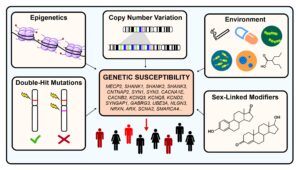Autism Spectrum Disorder (ASD) is a complex neurodevelopmental condition characterised by challenges in social communication, repetitive behaviours, and restricted interests. While the exact aetiology of ASD remains elusive, research suggests that both genetic and environmental factors play significant roles in its development.
Understanding the genetic and risk factors associated with ASD is crucial for early identification, intervention, and support for individuals affected by this condition.
Genetic Factors
Genetic factors are believed to be a primary contributor to the development of ASD. Studies have shown that individuals with ASD often have a higher likelihood of having a family history of the disorder.
Furthermore, identical twin studies have demonstrated a much higher concordance rate for ASD among monozygotic twins compared to dizygotic twins, indicating a strong genetic component.
- Heritability: Research suggests that ASD has a strong hereditary component, with estimates of heritability ranging from 70% to 90%. This means that genetic factors play a significant role in determining an individual’s susceptibility to ASD.
- Gene Mutations and Copy Number Variants (CNVs): Various genetic mutations and CNVs have been implicated in ASD. These include mutations in genes involved in synaptic function, neuronal development, and connectivity in the brain. For example, mutations in genes such as SHANK3, NLGN3, and NLGN4 have been associated with ASD. Additionally, certain CNVs, such as deletions or duplications of chromosomal regions, have been linked to an increased risk of ASD.
- Polygenic Risk: ASD is considered to be a polygenic disorder, meaning that it results from the combined effects of multiple genes. Genome-wide association studies (GWAS) have identified numerous genetic variants that contribute to ASD risk. However, each variant typically confers only a small increase in risk, and the cumulative effect of multiple variants determines an individual’s overall susceptibility to ASD.
- Gene-Environment Interactions: While genetic factors play a significant role in ASD susceptibility, interactions between genes and the environment may also influence its development. Environmental factors such as prenatal exposure to certain toxins, maternal infection during pregnancy, or complications during birth may interact with genetic predispositions to increase the risk of ASD.
Environmental Risk Factors
In addition to genetic factors, various environmental factors have been implicated in the development of ASD. These factors can interact with genetic susceptibilities and contribute to the complex aetiology of the disorder.
- Prenatal Factors: Several prenatal factors have been associated with an increased risk of ASD. Maternal exposure to certain environmental toxins, such as air pollution, pesticides, or heavy metals, during pregnancy has been linked to an elevated risk of ASD in offspring. Additionally, maternal use of certain medications or drugs during pregnancy, as well as maternal infections such as rubella or influenza, may increase the likelihood of ASD in offspring.
- Perinatal Factors: Complications during birth, such as preterm birth, low birth weight, or hypoxia, have been identified as potential risk factors for ASD. Birth complications may disrupt normal brain development and increase the vulnerability to neurodevelopmental disorders like ASD.
- Postnatal Factors: Early life experiences and environmental influences during infancy and childhood may also contribute to ASD risk. Factors such as exposure to environmental toxins, socioeconomic status, access to early intervention services, and quality of caregiving may influence the developmental trajectory of children at risk for ASD.
- Epigenetic Mechanisms: Epigenetic modifications regulating gene expression without altering the underlying DNA sequence have emerged as potential mechanisms linking environmental exposures to ASD risk. Environmental factors such as stress, diet, or exposure to toxins may induce epigenetic changes that affect gene expression patterns and contribute to the development of ASD.
Gene-Environment Interactions

The interplay between genetic and environmental factors is complex and multifaceted. Gene-environment interactions may modulate the risk of ASD by influencing gene expression, synaptic function, and neural circuitry.
- Susceptibility Genes and Environmental Triggers: Certain genetic variants may predispose individuals to ASD, but the expression of these susceptibility genes may be influenced by environmental factors. For example, a child with a genetic predisposition to ASD may only develop the disorder if exposed to specific environmental triggers during critical periods of development.
- GxE Interactions: Gene-environment (GxE) interactions refer to the combined effects of genetic predispositions and environmental exposures on ASD risk. Understanding these interactions is essential for unravelling the complex aetiology of ASD and developing personalized interventions tailored to individual risk profiles.
- Resilience Factors: While certain genetic and environmental factors may increase the risk of ASD, other factors may confer resilience and protect against the development of the disorder. Identifying resilience factors, such as supportive family environments or early intervention services, can inform strategies for promoting positive outcomes in individuals at risk for ASD.
In conclusion, both genetic and environmental factors play crucial roles in the aetiology of Autism Spectrum Disorder. Genetic studies have identified numerous susceptibility genes and variants associated with ASD. At the same time, environmental factors such as prenatal exposures, perinatal complications, and early life experiences may interact with genetic susceptibilities to influence ASD risk.
Understanding the complex interplay between genetic and environmental factors is essential for advancing our knowledge of ASD and developing effective strategies for early identification, intervention, and support for individuals affected by this complex neurodevelopmental disorder.










